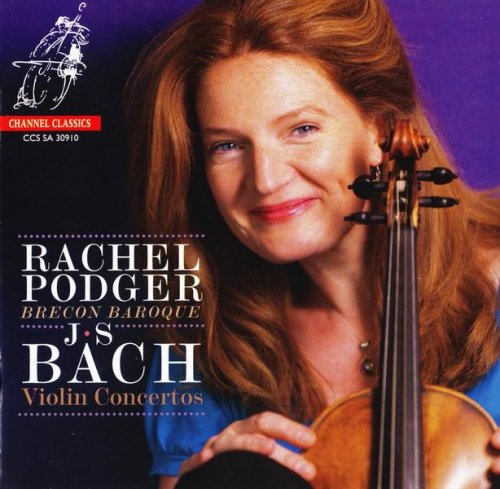Rachel Podger & Brecon Baroque - J.S. Bach: Violin Concertos (2010) [SACD]

Artist: Rachel Podger, Brecon Baroque
Title: J.S. Bach: Violin Concertos
Year Of Release: 2010
Label: Channel Classics
Genre: Classical
Quality: DST64 image (*.iso) 2.0 / 5.0
Total Time: 51:18 min
Total Size: 2.82 GB (artwork)
WebSite: Album Preview
Tracklist:Title: J.S. Bach: Violin Concertos
Year Of Release: 2010
Label: Channel Classics
Genre: Classical
Quality: DST64 image (*.iso) 2.0 / 5.0
Total Time: 51:18 min
Total Size: 2.82 GB (artwork)
WebSite: Album Preview
Johann Sebastian Bach (1685-1750)
Concerto In A Minor, BWV 1041
01. Allegro
02. Andante
03. Allegro Assai
Concerto In E Major, BWV 1042
04. Allegro
05. Adagio
06. Allegro Assai
Concerto In G Minor (after BWV 1056)
07. Allegro
08. Largo
09. Presto
Concerto In A Major (after BWV 1055)
10. Allegro
11. Largetto
12. Allegro Ma Non Tanto
The opportunity to spend three intensive days recording four Bach concertos is an uplifting experience. Each piece encompasses a unique expressive world where discovering the real essence of every movement becomes a kind of obsession! The concertos in A minor and E major are old friends. I’ve grown up with them and I played them a lot when young. The other two, in G minor and A major, were very familiar (as harpsichord concertos or in various transcriptions) – relations I knew reasonably well but not such close friends. It has been a delight to explore these pieces and renew acquaintance, first hand.
It’s not easy to pick out personal highlights in these richly-endowed works but here are a few. It was an unusual pleasure bubbling along with the cascading arpeggios in the A major (normally played by the right hand of the harpsichord ) and contrasting that with the soulful melody beginning in the lower registers of the instrument in the opening solo entry. An extraordinary sense of exhilaration! In contrast, The A minor brings something totally different, a kind of symmetrical quality: the clarity of structure in the first movement, the sense of freedom in the slow movement and then coming back down to earth with the vivacious fugal gigue to end. The focus for the player here is about structure and pace, the building up of excitement throughout each sequence towards the climaxes.
The E major concerto is life-embracing and joyful in its larger scale. The expression in the contemplative slow moves between a deep sense of sorrow and tender hope; you can’t help reflecting on Bach’s humanity and the endless creative tools at his disposal. What might have moved him at that moment of his life? Rachel Podger
It’s not easy to pick out personal highlights in these richly-endowed works but here are a few. It was an unusual pleasure bubbling along with the cascading arpeggios in the A major (normally played by the right hand of the harpsichord ) and contrasting that with the soulful melody beginning in the lower registers of the instrument in the opening solo entry. An extraordinary sense of exhilaration! In contrast, The A minor brings something totally different, a kind of symmetrical quality: the clarity of structure in the first movement, the sense of freedom in the slow movement and then coming back down to earth with the vivacious fugal gigue to end. The focus for the player here is about structure and pace, the building up of excitement throughout each sequence towards the climaxes.
The E major concerto is life-embracing and joyful in its larger scale. The expression in the contemplative slow moves between a deep sense of sorrow and tender hope; you can’t help reflecting on Bach’s humanity and the endless creative tools at his disposal. What might have moved him at that moment of his life? Rachel Podger

![Lionel Hampton - Jam Session (Remastered) (2022) [Hi-Res] Lionel Hampton - Jam Session (Remastered) (2022) [Hi-Res]](https://www.dibpic.com/uploads/posts/2025-12/1766651558_e3euc7osig6ec_600.jpg)


![The Eddie Higgins Trio, Nicki Parrott & Massimo Farao' - WINTER JAZZ SELECTION - Jazz at home (2023) [Hi-Res] The Eddie Higgins Trio, Nicki Parrott & Massimo Farao' - WINTER JAZZ SELECTION - Jazz at home (2023) [Hi-Res]](https://www.dibpic.com/uploads/posts/2025-12/1766736943_jah500.jpg)



